When we last left our gardener, she had just received her Fedco shrub order, shortly after removing one and a half pounds of dock root from the spot where she wanted to plant her Hydrangea ‘Endless Summer.’
Have you ever had a gardening project turn into a Project? Heh. If you’ve been gardening any length of time at all, I know you have. And if you haven’t gardened much, well, your turn is coming.
The first surprise was when I opened up the box. The hydrangea was already partially leafed out. But, I fretted, bareroot shrubs aren’t supposed to leaf out until after they’ve been planted. (Obviously my plants don’t read the plant books, just like my babies never seemed to read the baby care books.) The Fedco catalog said nothing about what to do in this circumstance, but there were really only two choices: pot it up and keep it protected until all danger of frost was past, or plant it in the ground and hope for the best. I decided I might as well plant it, since the chances of my remembering to bring it in every cold night for the next 50 or so days was not very good.
The Fedco invoice included in the box admonished, “Before you plant, please consult the planting instructions in your catalog. Read them before you grab your shovel.” These instructions include: plant within 48 hours or heel them in. Hmm. That means I should have them in the ground no later than Thursday evening. Could be tight. Heel them in? Where am I going to find the space to dig a trench and bury the roots? The vegetable garden is the only place I can think of that would be available without serious work, and, um, they’re getting ready to plant vegetables there. But why wouldn’t I just dig the permanent planting hole and plant them? Heeling in is a horticultural practice I’ve never really seen the point of. Further instructions from the Fedco catalog:
For best results plant on cool cloudy days in the early morning or late afternoon. Soak deciduous trees and shrubs for up to 24 hours before planting. Keep the roots from drying out. Even a few minutes in the sun and breeze can kill a tree or shrub.
These are the kind of directions that gave me fits as a new gardener. It sounds like you’ve got 48 hours to come up with a cool cloudy day or else you’ve got to dig a trench and plant them in the trench until a cool cloudy day comes along. Then you’ve got to pray that the cool cloudy day doesn’t turn out to be the day you have to take three kids to the dentist. I’ve learned that these directions are just telling you the ideal circumstances. The further away you get from the ideal circumstances, the greater risk you have of things not going well, but you do have some wiggle room. And as you will read, I certainly did some wiggling.
The following day I began shoveling compost onto the hydrangea bed. But since Wednesday is Library Day (weekly errand run) that’s all that got done: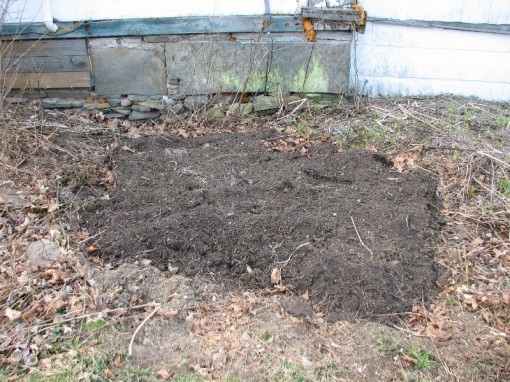 Thursday morning I realized it would have been smart to start soaking the shrub roots last night, but I figured a couple of hours’ soaking was better than nothing. I begin my day by trying to track down the bottle of seaweed extract we had around someplace, because I think I remember reading that soaking the roots in a solution of seaweed concentrate helped ease transplant shock. The closest thing I found was a gallon milk jug of already diluted seaweed stuff, and it was only about a third full. I had no idea what strength solution I should be soaking the roots in, or even if I should be soaking them in it, and that information was on the nowhere-to-be-found bottle. Oh, well, some is better than none. I think.
Thursday morning I realized it would have been smart to start soaking the shrub roots last night, but I figured a couple of hours’ soaking was better than nothing. I begin my day by trying to track down the bottle of seaweed extract we had around someplace, because I think I remember reading that soaking the roots in a solution of seaweed concentrate helped ease transplant shock. The closest thing I found was a gallon milk jug of already diluted seaweed stuff, and it was only about a third full. I had no idea what strength solution I should be soaking the roots in, or even if I should be soaking them in it, and that information was on the nowhere-to-be-found bottle. Oh, well, some is better than none. I think.
So I put the hydrangea into a five gallon bucket and poured the contents of the jug in. Then I filled up my two gallon watering can at the kitchen sink and poured that in. (Why didn’t I take the bucket outside and fill it from the tap? Because we still get frost most nights and haven’t opened the valve to the outside faucet yet. All water must be obtained from the house or the rain barrel until mid-May.) Then I realized I needed to plant, and therefore soak, all the shrubs today, not just the hydrangea (duh), and went outside to look around for a suitable container. I brought one of those utility tubs into the house, put the hydrangea in, and then trotted down to the basement, carefully extricated the winterberries from their politically correct, damp, shredded newspaper, brought them upstairs and put them in the tub. Then I poured the especially dilute seaweed solution over everything. The roots weren’t covered yet and they should not be allowed to dry out, so I filled up ye olde watering can again and poured it in. The roots still weren’t covered, but it occurred to me that it was probably getting pretty heavy and perhaps I should finish filling it up after moving it to its final resting spot. Sure enough, I could just barely lift it. If I didn’t have several Big Boys in residence I suppose I would have had to dipper out water until it was light enough for me to move, but since Lachlan was standing right there, I sheepishly asked him to move the utility tub to the shady side of the house for me. Then I added more water, this time from the rain barrel. It was at this point that it started to feel like a Project, and nothing had been planted yet!
Next I asked Evan to turn the compost into the leaf-soil mixture and dig the hole for the hydrangea. Well, leaf-soil mixture is probably a misnomer. Really it was moist clay soil on the bottom, not-very-rotted leaves on top of that, and pretty-well-rotted compost on top of that. I have read that hydrangeas like a leaf-moldy soil full of organic matter, and I was doing my best to oblige. Except, nothing was mixing very well. The native clay soil was pretty moist. Well, if you must know, it was too moist. You know that maxim that you shouldn’t work the soil until a squeezed clump of it fails to make a ball? This soil would make a ball that you would have to throw onto a concrete surface to get it to bust apart. But–I know April is the best time to plant bareroot plants in our area, and I know the soil won’t dry out sufficiently until May, and I know I don’t want to heel them in that long.
So I compromised. “Dig a large hole, at least twice as wide and about as deep as the root system.” I eyeballed the hydrangea roots and asked Evan to dig a hole about 2 1/2 feet wide and as deep as the shovel. The amendments weren’t exactly thoroughly mixed in, but I hoped the earthworms would finish the job. After Evan dug the hole, I mounded some soil in the bottom of it and laid the roots over the mound. I scooped up mounds of soil and dropped them over the roots. If the soil had been drier I would have pressed it down against the roots. But I was afraid to compact the overly moist soil too much. I just poured water from the watering can as I covered the roots with soil, and I’ve been keeping my eye on it to check for settling.
I forgot to take a picture right after I was done. Must be I had the five winterberry shrubs yet to be planted on my mind.
I wanted to plant them as a hedge in front of the chicken fence, to screen both the yard and the house from the street.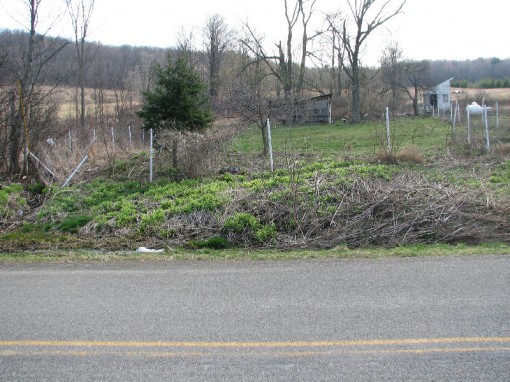 As I stood across the street to take this picture, our neighbor’s house is behind me to the left, and our house is in front of me but to the right. The two houses are situated diagonally from each other, so even though the hedge isn’t in front of the house, it will still screen the house from the neighbors’ view. At the far left, where the pvc pipe is leaning crazily, is the mouth of a seasonal brook, which drains into the roadside ditch. The bright green foliage all over belongs to the common tawny daylily, Hemerocallis fulva, which not for nothing is also called ditch lily. This whole area ranges from excessively moist to boot-sucking swampy, which, as you might imagine, rather limits what can survive here. It took me many months of pre-Internet research to learn that winterberry (Ilex verticillata) was 1) a native shrub that 2) provided berries for the birds as well as 3) winter interest and 4) liked wet soil and was even 5) hardy to Zone 3. A match made in heaven, I’d say. It took me this many years to get around to planting them because I strongly suspected it would be–you guessed it–a Project.
As I stood across the street to take this picture, our neighbor’s house is behind me to the left, and our house is in front of me but to the right. The two houses are situated diagonally from each other, so even though the hedge isn’t in front of the house, it will still screen the house from the neighbors’ view. At the far left, where the pvc pipe is leaning crazily, is the mouth of a seasonal brook, which drains into the roadside ditch. The bright green foliage all over belongs to the common tawny daylily, Hemerocallis fulva, which not for nothing is also called ditch lily. This whole area ranges from excessively moist to boot-sucking swampy, which, as you might imagine, rather limits what can survive here. It took me many months of pre-Internet research to learn that winterberry (Ilex verticillata) was 1) a native shrub that 2) provided berries for the birds as well as 3) winter interest and 4) liked wet soil and was even 5) hardy to Zone 3. A match made in heaven, I’d say. It took me this many years to get around to planting them because I strongly suspected it would be–you guessed it–a Project.
My teenaged son Collin was my next victim. I told him, as I told Evan, that I wanted him to dig four holes where I had placed stakes, about 30 inches wide and the depth of a shovel. Boy, did he act victimized! He glowered at me. He snarled, “When I agreed to do this digging for you, I thought it would take a couple of hours. I had no idea you wanted me to dig holes big enough to bury a man in!” and he stomped off to the first hole, muttering. I was dumbfounded. I had no idea what he was mad about, and I just wrote it off as adolescent angst. I mean, he wasn’t digging happily, but he was digging.
By the time I was done puttering around with the hydrangea, I saw he was done with the first hole and working on the second, so I brought the first winterberry over. “Don’t bother planting anything there yet, that hole isn’t nearly done,” he grumbled at me. “What do you mean?” I replied, “It looks like it’s deeper than I asked you to dig it.” Now it was his turn to look at me dumbfounded. Suddenly doubting my own estimation, I brought the shovel over and held it against the side of the hole. Sure enough, the hole went down a good six inches past the shovel head. “See? The hole is deeper than the head of the shovel.” “Mom, you said to dig it to the depth of the shovel! That includes the handle!” Unlike Evan, Collin isn’t much of a plant guy, and I’m not one for precision in my spoken language. Once we had a chuckle over that misunderstanding, Collin went back to digging much more cheerfully.
Slurp. Splat. Slurp. Splat. I was beginning to doubt my research. Did it say winterberries liked moist soil . . . slurp. splat! . . . or wet soil? No turning back now. The first hole he had dug was the one near the mouth of the brook. The water table was so high there that there were two perpetual inches of water in the bottom of the hole, and the clay was an ugly grey color that filled me with misgiving. I brought a wheelbarrow full of municipal compost to help me fill in the planting holes. The compost would take the place of all the rocks Collin unearthed while digging.
I shovelled some clay into the bottom of the hole: splash! I placed the shrub on top of the clay, spreading the roots out. I had Collin hold it upright while I shoveled more clay around the roots to anchor it. Once it was steady I let him go back to digging and alternately shoveled compost and clay. And before I knew it, the first winterberry was “planted.”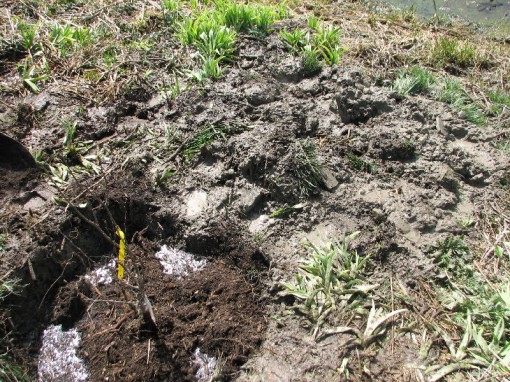 Despite being further uphill than the first hole, this second hole had more water in it. I finally realized all the trampling had caused a rivulet to flow into the hole. You can see a hint of current on the surface of the water:
Despite being further uphill than the first hole, this second hole had more water in it. I finally realized all the trampling had caused a rivulet to flow into the hole. You can see a hint of current on the surface of the water: 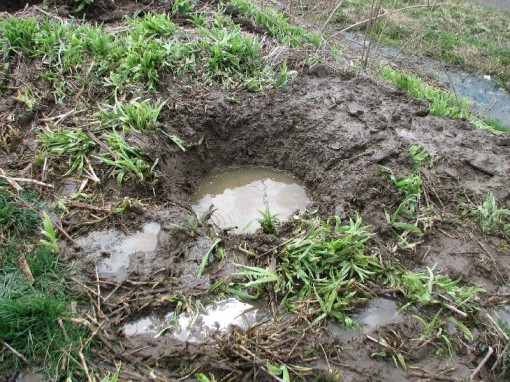 Once I dammed up and redirected the rivulet, and cut a little channel on the downhill side of the hole to let the water out, the hole emptied and didn’t refill. Otherwise planting the second one went the same as planting the first one.
Once I dammed up and redirected the rivulet, and cut a little channel on the downhill side of the hole to let the water out, the hole emptied and didn’t refill. Otherwise planting the second one went the same as planting the first one.
Collin was digging holes much faster than I was filling them. As a matter of fact, he was done. But I had forgotten about the male winterberry that also needed planting, the ‘Southern Gentleman.’ It doesn’t make the decorative berries, but it does pollinate the ones that do, so it needs to be nearby but not necessarily out in view. I wanted to plant this inside the chicken yard. Since Lachlan keeps this area mowed, I consulted with him as to the most convenient placement. I wanted to plant it behind the evergreen visible in the second photo from the top, but Lachlan pointed out to me that the evergreen would only keep growing and would soon crowd it out. So we decided to plant it where I had twice tried to grow a Viburnum trilobum with no success. Collin dug a hole there, which immediately filled with water to within two inches of ground level–with no visible source to the water!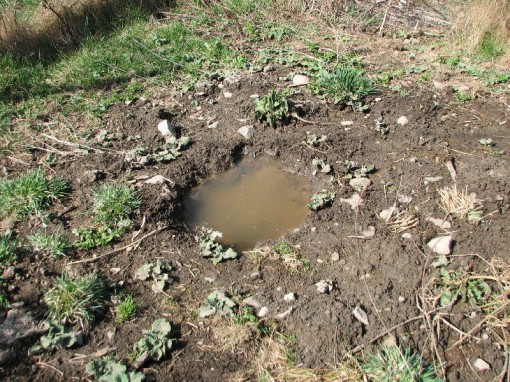 No wonder I could never get a viburnum to grow there.
No wonder I could never get a viburnum to grow there.
I managed to plant one more shrub before having to quit for the day and start cooking supper. That meant my 48 hours were up and all the shrubs were not yet planted. The last two, one female ‘Winter Red’ and one male ‘Southern Gentleman,’ spent the night in the utility tub. Fortunately it was a mild night. It only got down to 38 F (3 C).
Friday I planted the last of the four ‘Winter Red’ winterberries. But Rundy pointed out to me that the evergreen, which had been planted the first year we moved in, was now under a utility line (which had been installed several years after we planted the tree) and needed to be cut down sooner or later, so why not sooner? Then I could plant the ‘Southern Gentleman’ over by the edge of the property where it would be less conspicuous and more convenient to the one mowing this area. We both agreed that we should wait until my DH got home and run it by him before Rundy actually took it down. That meant my poor ‘Southern Gentleman wouldn’t get planted until Saturday, well over 84 hours from when the package was delivered, and well over 24 hours soaking in that tub. I just had to hope it wouldn’t be too set back by the delay, because it would really be a in a better spot in the end.
As expected, Dad gave his okay for the tree removal, and Saturday morning Rundy cut it down and dragged it out of my way.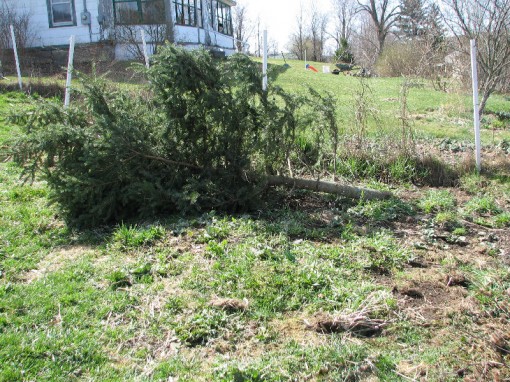 Finally I was able to plant my ‘Southern Gentleman.’ After all that practice, it went fairly quickly.
Finally I was able to plant my ‘Southern Gentleman.’ After all that practice, it went fairly quickly.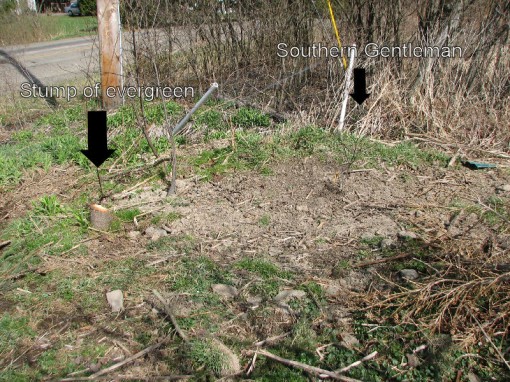 I’ll keep you posted on their progress. We’ll all eventually learn if the rules I wiggled adversely affected the shrubs’ growth. When it was all over with, I did go back and check the info I had on winterberries. Native Plants of the Northeast : A Guide for Gardening & Conservation
I’ll keep you posted on their progress. We’ll all eventually learn if the rules I wiggled adversely affected the shrubs’ growth. When it was all over with, I did go back and check the info I had on winterberries. Native Plants of the Northeast : A Guide for Gardening & Conservation by Donald Leopold states:
Soil: moist to wet, including prolonged standing water; best in organic soils that are acidic
So I think the excessive wetness will be all right, and I hope the compost I added to each hole will improve the organic end of things enough to be adequate. Only time will tell.




Oh, and my sympathies to Collin. And to you. Hard to tell when the teenaged tendency to hyperbole crosses into something real.
“Deeper than a shovel.”
!!!
I’d’ve wailed, too! (But then, I’m a gardener and would have known exactly ‘how’ you meant it.)
To further Don’s commentary – you can use a bit of floting row cover to keep the frost off, and this can be left in place until the weather settles, as it lets in light.
My little local nursery uses the row covers over their plants in this iffy weather (they of course, pull the cloth off for display and replace it each night.)
Don,
The hydrangea is planted on the north side of the house, and I don’t think shade cloth will provide more shade than the house does. But I already found out the hard way about the freezes. (I love having garden friends come to visit and offering their hard-won advice.)
Kathy,
You might need to use some shade cloth over that hydrangea until it gets its roots down, if your weather turns hot; nothing leaf wilts worse than those big leafed macrophyllas. Even when they are planted from pots, they usually wilt badly on hot, dry days for the first couple of years around here. Be sure to protect it from late spring freezes too… they are very sensitive to leaf damage from freezing. (I love this feeling of being in a bunch of people standing around in your yard telling you what to do with your new shrubs!)
Don
Judy, thank you for that great information about heeling in. That swampy clay only occurs in that one corner of the property, so I don’t have to face it too often.
It’s one of those Gardening Sagas we collect on ourselves! Like the time I was sent by the nursery I was working for to “transplant some peonies” which turned out to be a driveway-length row that had been in situ for 25 years, in clay soil…some of the roots were literally the size of my leg.
I salute your ability to cope with that kind of swampy clay.
I think I can safely say your directions said 48 hours because they wanted to be sure you would get on the project, not leave them in the box for a week before looking at them. You’d be amazed at some of the confessions I get!
Heeling in is a relict from the days when people had gardeners, and from the trade, where you get a semi-truckload of plants, some b&b, some bare root, and those 500 spirea and 80 fruit trees & 200 roses just have to wait so they get heeled in. You can use a big pile of mulch for that, it doesn’t have to be a literal trench. Slice a big hole in the side of the mulch pile, stand the plants in the slice so their roots (or more) are covered, and soak the patootie out of the whole thing. If you can provide yourself with a pile of mulch (shredded bark, whatever is cheap locally) in the fall, and tarp it so it is not a pile of frozen chips in the spring, you’ll have a ready-made heeling in spot above the waterline. If you can do this in a shady spot, perfecto. Or if you have a dark shed with a concrete floor (an unused garage is great), just sling everything in there, water them down, spread said mulch liberally over the root area, water again & shut the door. Dark/cold/damp—pretty much like being in the ground. Then you can dig your holes at a reasonable pace.
Nota bene: don’t use soil for the mulch/heeling in pile; tender new roots will spring into the soil and get broken off when planting. They can’t hang on to a friable mulch and won’t be harmed by being shaken out of it.
Okay, I feel better now. Maybe my call in the middle of the “PROJECT” kept you from planting the “Southern Gentleman” in the wrong place!! This write-up, assuming that all does go well, should give hope to those of us who really don’t know what to do when plans go awry!
What a heroic story. Don’t we all order more plants than we can readily cope with? Some friends of mine gave me a wild plum whip that had spent 1 1/2 years in a bucket of water, and it was still alive. On the other hand, our neighbor paid our teenage sons to plant literally hundreds of little trees and then neglected to water them. A handful survived.